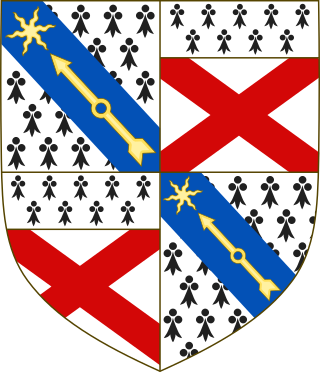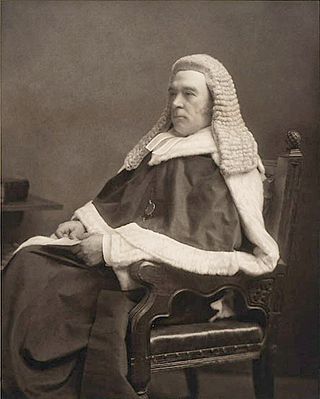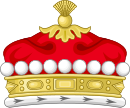
Earl of Derby is a title in the Peerage of England. The title was first adopted by Robert de Ferrers, 1st Earl of Derby, under a creation of 1139. It continued with the Ferrers family until the 6th Earl forfeited his property toward the end of the reign of Henry III and died in 1279. Most of the Ferrers property and the Derby title were then held by the family of Henry III. The title merged in the Crown upon Henry IV's accession to the throne in 1399.
The Peerage of the United Kingdom is one of the five Peerages in the United Kingdom. It comprises most peerages created in the United Kingdom of Great Britain and Ireland after the Acts of Union in 1801, when it replaced the Peerage of Great Britain. New peers continued to be created in the Peerage of Ireland until 1898

Marquess of Lansdowne is a title in the Peerage of Great Britain created in 1784, and held by the head of the Petty-Fitzmaurice family. The first Marquess served as Prime Minister of Great Britain.

Marquess of Headfort is a title in the Peerage of Ireland. It was created in 1800 for Thomas Taylour, 2nd Earl of Bective.

Baron Byron, of Rochdale in the County Palatine of Lancaster, is a title in the Peerage of England. It was created in 1643 by letters patent for Sir John Byron, a Cavalier general and former Member of Parliament. The peerage was created with remainder to the heirs male of his body, failing, to his six brothers: Richard, William, Thomas, Robert, Gilbert, and Philip, and the heirs male of their bodies. Lord Byron died childless and was succeeded according to the special remainder by his next eldest brother Richard, the second Baron.
Baron Kerry is an ancient title in the Peerage of Ireland, named after County Kerry. It was created circa 1223 for Thomas FitzMaurice, Lord OConnello, son of Maurice FitzGerald, Lord of Llanstephan.

Lord Elphinstone is a title in the Peerage of Scotland created by King James IV in 1510.

Earl of Powis (Powys) is a title that has been created three times. The first creation came in the Peerage of England in 1674 in favour of William Herbert, 3rd Baron Powis, a descendant of William Herbert, 1st Earl of Pembroke. In 1687, he was further honoured when he was made Marquess of Powis.

Earl of Plymouth is a title that has been created three times: twice in the Peerage of England and once in the Peerage of the United Kingdom.

Viscount St Davids, of Lydstep Haven in the County of Pembroke, is a title in the Peerage of the United Kingdom. It was created in 1918 for John Philipps, 1st Baron St Davids. The Philipps family descends from Sir John Philipps, who represented Pembrokeshire in the House of Commons. In 1621 he was created a Baronet, of Picton Castle in the County of Pembroke, in the Baronetage of England. His grandson, the third Baronet, also sat as Member of Parliament for Pembrokeshire. He was succeeded by his son, the fourth Baronet. He represented Pembroke and Haverfordwest in Parliament. His son, the fifth Baronet, sat for Haverfordwest. He was succeeded by his younger brother, the sixth Baronet. He represented Carmarthen, Petersfield and Pembrokeshire in the House of Commons.

Lord Nairne is a title in the Peerage of Scotland, created by Charles II for Sir Robert Nairne of Strathord in 1681, which since 1995 is held by the Viscount Mersey.
Baron Skelmersdale, of Skelmersdale in the County Palatine of Lancaster, is a title in the Peerage of the United Kingdom. It was created in 1828 for the former Member of Parliament for Westbury, Newcastle-under-Lyme, Clitheroe and Dover, Edward Bootle-Wilbraham. His grandson, the second Baron, was a Conservative politician and served in the Conservative administrations of Disraeli and Lord Salisbury. In 1880 he was created Earl of Lathom, in the County Palatine of Lancaster, in the Peerage of the United Kingdom. However, the earldom became extinct on the death of his grandson, the third Earl, in 1930. The barony passed to the last Earl's second cousin once removed, the fifth Baron, who was the grandson of a younger son of the first Baron. On his death, the title was inherited by his cousin, the sixth Baron.

Baron Milford is a title that has been created three times, once in the Peerage of Ireland and twice in the Peerage of the United Kingdom. All three creations have been for members of the same family. The first creation came in the Peerage of Ireland in 1776 when Sir Richard Philipps, 7th Baronet, of Picton Castle was made Baron Milford. However, this title became extinct on his death in 1823, while the baronetcy was passed on to a distant relative. The title was revived in the Peerage of the United Kingdom in 1847 when Sir Richard Philipps, 1st Baronet, of Picton Castle was created Baron Milford, of Picton Castle in the County of Pembroke. Born Richard Bulkeley Philipps Grant, he was the son of John Grant and Mary Philippa Artemisia, daughter of James Child and Mary Philippa Artemisia, daughter of Bulkeley Philipps, uncle of the first Baron of the first creation. He succeeded to the Philipps estates in 1823 and assumed the surname of Philipps the same year. In 1828 he was created a Baronet, of Picton Castle in the County of Pembroke, in the Baronetage of the United Kingdom. However, Lord Milford was childless and the titles became extinct on his death in 1857. He devised his estates to his half-brother Reverend James Henry Alexander Gwyther, who assumed the surname of Philipps. James's daughter Mary Philippa married Charles Edward Gregg Fisher, who assumed the surname of Philipps and was created a Baronet, of Picton, in 1887.

Charles Maurice Petty-Fitzmaurice, 9th Marquess of Lansdowne,, styled Earl of Shelburne between 1944 and 1999, is a British peer, landowner and army officer.
George John Charles Mercer Nairne Petty-Fitzmaurice, 8th Marquess of Lansdowne, DL, was a British peer and Conservative politician.

Lieutenant-Colonel Henry William Edmund Petty-Fitzmaurice, 6th Marquess of Lansdowne, DSO, MVO, styled Earl of Kerry until 1927, was a British soldier and politician.
Major General Sir Christopher John Airy, is a retired British Army officer who served as General Officer Commanding the London District and Major-General commanding the Household Division from 1986 to 1989.

Violet Astor, Baroness Astor of Hever DStJ, styled Lady Charles Fitzmaurice between 1909 and 1914 and Lady Charles Mercer Nairne between 1914 and 1918, was an English aristocrat.

John Charles Bigham, 1st Viscount Mersey, was a British jurist and politician. After early success as a lawyer and a less successful spell as a politician, he was appointed a judge and worked in commercial law.
Charles Clive Bigham, 2nd Viscount Mersey, was a British peer and Liberal politician.












